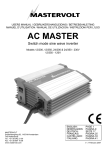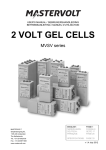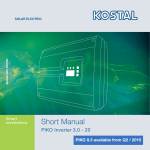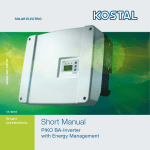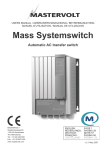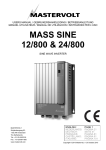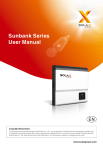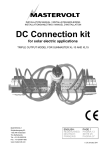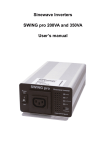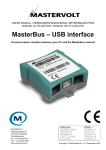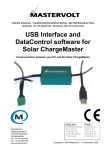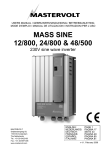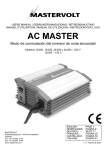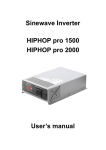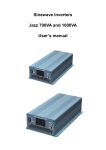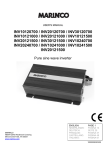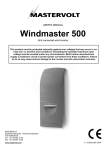Download AC MASTER
Transcript
USERS MANUAL / GEBRUIKERSHANDLEIDING / BETRIEBSANLEITING MANUEL D’UTILISATION / MANUAL DE UTILIZACION / INSTRUZIONI PER L’USO AC MASTER Switch mode sine wave inverter Models 12/200, 12/350, 24/200 & 24/350 - 230V 12/350 - 120V MASTERVOLT Snijdersbergweg 93, 1105 AN Amsterdam The Netherlands Tel.: +31-20-342 21 00 Fax: +31-20-697 10 06 www.mastervolt.com ENGLISH: NEDERLANDS: DEUTSCH: FRANÇAIS: CASTELLANO: ITALIANO: PAGE 1 PAGINA 9 SEITE 17 PAGINA 25 PÁGINA 33 PAGINA 41 v 1.0 July 2006 ENGLISH 1 QUICK INSTALLATION INSTRUCTIONS This section provides a brief overview of a basic stand alone installation of the AC Master 5 Connect the battery to the DC input. Integrate a fuse holder in the positive battery wire, but do not place the fuse yet. However; please review the entire manual for connection of additional features and to ensure best performance and years of trouble-free operation. – black wire Use isolated tools! Read safety instructions (page 3) + red wire 2 Disconnect the electrical power: • • • • Switch off all consumers, Switch off all charging systems. Remove the battery fuse. Check with a suitable voltmeter whether the DC installation is voltage free. Connect the red wire to +, black wire to –. Incorrect polarity will damage the AC Master! 6 3 4 Move the main switch of the AC Master to the OFF position Mount the AC Master with four screws to a solid surface. Allow at least 10 cm / 4 inch space around the apparatus! For safe installation: • Connect the grounding point of the AC Master to the central grounding point of the vehicle/ ship. • If you need to install a Residual Current Device (RCD) in the wiring of the AC output, both the earth (PE/GND) and the neutral (N) of the AC output of the AC Master must be connected to the grounding point Refer to local applicable regulations on these issues. 7 2 The AC load can be connected directly to the AC socket. • Place the inverter fuse. • Switch on the AC Master. USER’S MANUAL AC MASTER PRODUCT DESCRIPTION AND APPLICATION The Mastervolt inverter “AC Master” converts a DC voltage to a pure AC sine wave voltage. SAFETY INSTRUCTIONS WARNING! Before using the AC Master, read and save the safety instructions • Use the AC Master in accordance with the instructions and specifications stated in this manual. • Connections and safety features must be executed according to the locally applicable regulations • Operation of the AC Master without proper grounding may lead to hazardous situations! • Use DC-cables with an appropriate size. Integrate a fuse in the positive wiring and place it nearby the battery. Refer to the specifications. • If the positive and negative wires on the DC-input (battery) are exchanged, the AC Master will be damaged. Damage of this kind is not covered by guarantee. Check whether all connections are connected correctly before placing the fuse. • Do not connect the AC-output of the inverter to an incoming AC source. • Never open the housing as high voltages may be present inside! c AC-output d LED indicator ENGLISH UNPACKING The delivery consists of the following parts: • The AC Master (incl. DC cables) • This user’s manual After unpacking, check the AC Master for possible damage. Do not use the AC Master if it is damaged. If in doubt, contact your supplier. OUTPUT FREQUENCY See figure 1. On the front side of the AC Master a small switch (3) can be found to adjust the output frequency. The output frequency is factory set to the correct value. If necessary, use a small flat-blade screw driver to adjust the output frequency (50 or 60Hz) CHOOSING A LOCATION TO INSTALL • Install the AC Master in a well-ventilated room protected against rain, vapour, moisture and dust. • Ambient temperature: 0 ... 40°C; • Never use the AC Master at a location where there is danger of gas or dust explosions • Mount the AC Master in such a way that obstruction of the airflow through the ventilation openings is prevented. No objects must be located within a distance of 10 cm / 4 inch around the AC Master. • Use the included battery cables to connect the AC Master to the DC supply • Do not install the AC Master in the same compartment as the batteries. Do not mount the AC Master straight above the batteries because of possible corrosive sulphur fumes. f Main switch g Cooling fan h DC input Rear side Front side Figure 1 i Remote connection j Grounding point e Output frequency 3 ENGLISH USER’S MANUAL AC MASTER INSTALLATION Before you start • Be sure that the output of the supplying source (battery) is switched off during installation. Also be sure that no consumers are connected to the battery during installation, to prevent hazardous situations. • Before installing the AC Master make sure the main switch (figure 1, ref. 4) is set to the OFF position. • Check that the battery voltage is the same as the input voltage of the AC Master (e.g. 24V battery for a 24V input voltage). Also check that the output voltage satisfies loading requirements • A DC fuse holder must be integrated in the positive wiring. The DC fuse should be placed last of all. • Use four Ø4.5mm screws to mount the AC Master to a solid surface. See figure 3. Wiring • DC Wring. Connect DC wiring as shown in figure 2: the black wire (9) NEG (–) to the negative (–) pole of the power source / battery, the red terminal (10) POS (+) to the positive (+) pole of the power source/ battery. Integrate a DC fuse holder in the positive wiring, but do not place the fuse yet. Make sure that all DC connections are tight. • Chassis ground: Use a cable AWG8 / 6 mm² to connect the CHASSIS GROUND terminal (8) to the central ground. • 120V models (part nr. 28520350): the neutral connector N of the AC output (1) is automatically connected to the CHASSIS GROUND terminal when the inverter is in operation. • 230V models: the neutral connector N of the AC output (1) is not connected to the CHASSIS GROUND terminal. • Remote operation switch (option). If you want to operate the AC Master on a remote location, you can install a switch as indicated in figure 2. When the contact is closed, the AC Master is switched on. AC Master f k Black wire NEG (–) l Red wire POS (+) j Fuse + Fuse holder Grounding point Do not place the fuse before the entire installation is completed Remote operation switch (option) Figure 2 4 Battery USER’S MANUAL AC MASTER COMMISSIONING AFTER INSTALLATION 1. Check the polarity of the DC-connections. Do not place the DC fuse if the polarity is not correct. 2. Place a DC-fuse (see SPECIFICATIONS) in the fuse holder. When placing this fuse, a spark may occur, caused by internal capacitors of the AC Master. This is normal. 3. AC voltage: the load can be plugged into the AC-output (1) directly. Do not connect the ACoutput of the AC Master to an incoming AC source. OPERATION Switching on: Move the main switch (4) to “ON”. The AC Master will start a self-test indicated by two beeps from the buzzer and a flashing LED indicator (2). This may last for approximate two seconds. Finally the buzzer will produce another beep and the AC Master will switch on, indicated by an illuminating green LEDindicator (2). Now the AC Master is ready to supply load connected to the AC-output (1). Switching off: Move the main switch (4) to the “OFF” position. Note that switching off the AC Master does not break the connection to the batteries! Remote operation: The AC Master can be operated on a remote location by means of an optional remote switch. Move the main switch (4) to the “REMOTE” position. When the remote contact is closed, the AC Master is switched on . LED indicator The operation mode of the AC Master is made visible by means of the LED indicator (2) As long this LED isn’t illuminated red, no failure is detected: the AC Master is operating normally. If an error occurs, it is detected by the apparatus itself: the LED indicator turns red. Indication of the LED Meaning GREEN RED Inverter is working normally Failure. Possible causes: overload / short circuit Failure. Possible causes: DC-input voltage too high or too low, internal temperature too high, RED blinking ENGLISH Maintenance No specific maintenance is required. If necessary, use a soft clean cloth to clean the AC Master. Never use any liquids, acids and/or scourers. Check the wiring on a regular base. Defects such as loose connections, burnt wiring etc. must be corrected immediately. DECOMMISSIONING Proceed as follows for decommissioning of the AC Master: 1. Move the main switch (4) to the OFF position. 2. Remove the DC fuse. Be sure that others can not reverse this action taken. 3. Now the AC Master can be demounted in a save way. GUARANTEE TERMS Mastervolt guarantees that this product was built according to the legally applicable standards and stipulations. During production and before delivery all products are exhaustively tested and controlled. If you fail to act in accordance with the regulations, instructions and stipulations in this user’s manual, damage can occur and/or the product will not fulfil the specifications. This may mean that the guarantee will become null and void. The guarantee is limited to the costs of repair and/or replacement of the product by Mastervolt only. Costs for installation labour or shipping of the defective parts are not covered by this guarantee. For making an appeal on warranty you can directly contact your supplier, mentioning your complaint, application, date of purchase and part number / serial number. The standard guarantee period is 2 years. LIABILITY Mastervolt cannot be held liable for: • Possible errors in this manual and the consequences of these. • Use that is inconsistent with the purpose of the product. 5 ENGLISH USER’S MANUAL AC MASTER TROUBLE SHOOTING Consult an installer, if you cannot solve the problem by means of the table below. Problem No output voltage, the LED indicator (2) is off No output voltage, the LED indicator (2) is lit red. No output voltage, the LED indicator (2) is blinking red. Possible cause Main switch (4) is set to OFF Main switch (4) is set to REMOTE, but no remote present The remote switch is off (if applied) DC fuse blown AC Output overloaded DC input voltage too high DC input voltage too low (flat battery) Airflow insufficient Inverter switches on and off. LED indicator (2) is blinking alternately red and green DC input voltage too low because of voltage drop across the DC cables due to too long or too narrow cables Flat battery Loose or corroded connections Some loads like televisions and clocks do not operate correctly Wrong setting of output frequency What to do? Set the main switch (4) in ON position Set the main switch (4) in ON position Close the remote operation switch Replace the fuse Reduce the load and let the inverter cool down. The AC Master will switch on again when the internal temperature has reduced Check battery voltage; switch off charger. The inverter will switch on again if the input voltage is < 15.5V or < 31.0V Charge the battery. The inverter will switch on again when the input voltage is > 14.6V or > 29.2V Check the airflow through the inverter. The operation of the cooling fan (5) should not be blocked. Reduce the length of the DC cables or use cables with a larger cross section. Disconnect the load and recharge the battery Tighten the connections; burnt cables must be corrected immediately. Check the specified input frequency of the load with the output frequency of the AC Master. If necessary, adjust the output frequency. See OUTPUT FREQUENCY. EC DECLARATION OF CONFIRMITY Manufacturer Mastervolt Address Snijdersbergweg 93, 1105 AN Amsterdam , The Netherlands Herewith declares that product:: 28010200 28010350 AC Master 12/200-230V AC Master 12/350-230V 28020200 28020350 AC Master 24/200-230V AC Master 24/350-230V Is in conformity with the provision of the EC EMC directive 89/336/EEC and amendments 92/31/EEC, 93/68/EEC. The following harmonised standards have been applied: Generic emission standard: EN 55022: 1998+A1: 2000+A2: 2003 Generic Immunity standard: EN 55024: 1998+A1: 2001+A2: 2003 Harmonic current emissions: EN 61000-3-2: 2000 Fluctuations and flicker: EN 61000-3-3: 1995 + A1: 2001 Safety directive 73/23/EEC and amendment 93/68/EEC, with the following standard: Low voltage standard: EN 60950: 2000 Amsterdam, R.J. ter Heide, General Manager MASTERVOLT 6 USER’S MANUAL AC MASTER ENGLISH SPECIFICATIONS Model AC Master Part number: Function of the apparatus: Manufacturer: General Nominal battery voltage: Nom Power Tamb=25°C, cos phi 1 P30 Power Tamb=40°C, cos phi 1 Max. peak load Output waveform Maximum efficiency Output voltage Frequency (selectable) Dimensions Weight: Protection degree Technical Technology Shut down voltage low battery Restart voltage low battery Shut down voltage high battery Restart voltage high battery Maximum allowed ripple on DC Input current @ nominal load External DC fuse required Recommended battery capacity: DC cable AC connection* No load power consumption (off mode): No load power consumption ON @ Unom: Operating temperature specified (will meet specified tolerances) Practical operating temperature (may not meet specified tolerances) Cooling: Non-operating temperature (storage temperature) Relative humidity Safety: EMC E-mark (95/54 CE) Protections Protections: Reversed polarity: * Other variants upon request 12/200-230V 12/350-230V 24/200-230V 24/350-230V 28010200 28010350 28020200 28020350 Conversion of a DC voltage to a pure AC sine wave voltage Mastervolt, Amsterdam, the Netherlands 12/350-120V 28520350 12VDC 12VDC 24VDC 200W 350W 200W 200W 350W 200W 400W 700W 400W True sinewave 90% 86% 93% 230V ±5% 230V ±5% 230V ±5% 50Hz ±0.03Hz 50Hz ±0.03Hz 50Hz ±0.03Hz 74 x 152 x 242 mm / 2.91 x 5.98 x 9.53 inch 1.65kg/3.6Lbs 1.85kg/4.1Lbs 1.65kg/3.6Lbs IP21 IP21 IP21 24VDC 350W 350W 700W 12VDC 350W 350W 700W 89% 230V ±5% 50Hz ±0.03Hz 84% 120V ±5% 60Hz ±0.03Hz 1.85kg/4.1Lbs IP21 1.85kg/4.1Lbs IP21 20.6V (±0.5V) 24.6V (±0.5V) 30.6V (±0.5V) 29.2V (±0.5V) 10.3V (±0.5V) 12.3V (±0.5V) 15.3V (±0.5V) 14.6V (±0.5V) 25A 30A >40Ah 38A 40A >80Ah HF / Switch mode 10.3V (±0.5V) 10.3V (±0.5V) 20.6V (±0.5V) 12.3V (±0.5V) 12.3V (±0.5V) 24.6V (±0,5) 15.3V (±0.5V) 15.3V (±0.5V) 30.6V (±0.5V) 14.6V (±0.5V) 14.6V (±0.5V) 29.2V (±0.5V) 5% RMS 23A 38A 15A 30A 40A 20A >50Ah >80Ah >25Ah included Continental European socket CEE-7/7 US/NEMA 5-15 0mA 0mA 0mA 0mA 0mA 0.8A 0.8A 0.5A 0.5A 0.8A Full specifications at ambient temperature 0 to 40°C (32 to 104°F), Derating with 5%/°C (3%/°F) at 40 to 60°C (104 to 140°F), Shutdown at over temperature, auto recover after cooling down Ambient temperature -25 to 40°C (-13 to 104°F) Derating with 5%/°C (3%/°F) at 40°C to 60°C (104 to 140°F). Shutdown at over temperature, auto recover after cooling down Temperature and load regulated fan Ambient temperature -30°C to 70°C / -22°F to 158°F Protected against humidity and condensing air by conformal coating on both sides of all PCB’s. Max 95% relative humidity, non-condensing. EN 60950-1 EN55022, EN61000-3-2, EN61000-3-3, EN55024 FCC class A E13 - 3496 n/a Overload, short circuit, over / under voltage, over temperature Internal fuse, reversed polarity may lead to permanent damage 7 ENGLISH USER’S MANUAL AC MASTER OUTLINE DRAWING Figure 3 © Mastervolt BV, Snijdersbergweg 93, 1105 AN Amsterdam, Netherlands Tel: + 31-20-3422100 Fax: + 31-20-6971006 Email: [email protected] Mastervolt cannot be held liable for possible errors in the manual and the consequences of these 8








